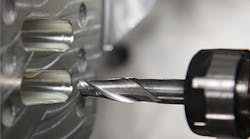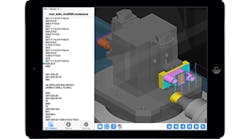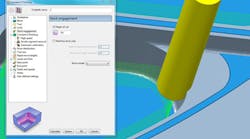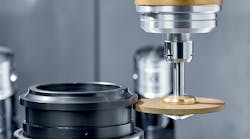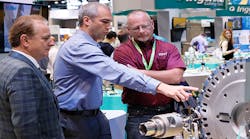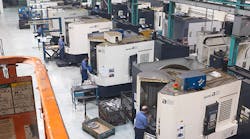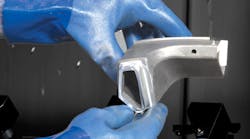PowerMill — the 3D CAM platform for Windows developed by Delcam Plc — is among the most widely subscribed software program for two- to five-axis CNC machines, used in numerous industrial sectors to develop machining toolpaths — and subscribers and prospective users will see a detailed preview of the software’s next release at IMTS 2014.
As reported by Delcam, among the new functions in PowerMill 2015 will be an updated Vortex high-speed area-clearance strategy (introduced at IMTS 2012) that produces safe toolpaths with a much deeper cut by using a controlled engagement angle to maintain the optimal cutting conditions for the whole toolpath. As a result, higher feed rates and material-removal rates are possible, making the cutting time shorter by as much as 70%.
In addition, cutting proceeds at a more consistent volume-removal rate and at a near-constant feedrate, so extending tool life and protecting the machine.
Two enhancements in PowerMill 2015 will give even greater reductions in machining time compared to conventional roughing. The first change allows toolpaths to approach the part from outside the stock at the cutting height for open pockets or in areas where earlier cuts have made this possible. Previously, all entry moves had to be made by plunging onto the surface or by ramping into the material.
The second change allows an increased feed rate to be set for non-cutting moves. The default value is set at double the rate for the cutting moves but this can be altered as required for each machine tool. The extra time that can be saved depends on the shape of the part but an additional saving of around 20% should be expected above the earlier releases of Vortex.
Another problem in previous versions of PowerMill was that unnecessary lifts could be added to area-clearance toolpaths when the cutter moved outside the stock or close to its edge. Now, changes to the roughing algorithm have reduced the number of lifts per toolpath slice to the minimum needed and so made area clearance much more efficient.
Companies using PowerMill for either positional or continuous five-axis machining will benefit from improvements to the collision checking within the software. First, collision checking has been changed so that warnings can also be flagged for near misses. Now, users can specify a clearance value and when the machine tool comes within this value it will turn yellow in color to highlight a near miss. Collisions will still be shown by a change of color to red.
Second, the display showing the list of collisions, and now near misses as well, has been updated to be easier to read, making it simpler to extrapolate the coordinates at these points. For near misses, the clearance distance is shown in the display, with the distance shown as zero for collisions.
Another improvement will help companies using four- or five-axis machines with trunnions or similar tilting tables. Previously, PowerMill toolpaths could exhibit unwanted changes of azimuth as the cutting tool approached a position vertical to the part. This would slow down the machine, often to the extent that a witness mark would be left on the surface.
Now, options are available to specify the information used by PowerMill to distribute the toolpath points so that the machine’s gimbal-lock position is avoided and a smoother motion results.
Raster finishing has been improved in PowerMill 2015, with the software now able to set automatically the most appropriate angle for each region of the part. In previous versions, the user had to select each area and specify the angle manually.
The new option, which provides the same functionality that already existed for steep-and-shallow finishing and face milling, is most beneficial when finishing a series of pockets aligned in different directions.
A number of improvements have been made to the PowerMill interface. Most important is a clearer form for the strategy selector that makes navigation easier when choosing which strategy to use. It has also been made easier to create folders of strategies, for example, those most suitable for a particular machine tool, material or type of part, and to add and remove strategies from those folders.
Finally, three new curve-creation options have been added to the curve editor – ellipse, spiral and helix. These options can be used to create patterns or boundaries when generating toolpaths.
